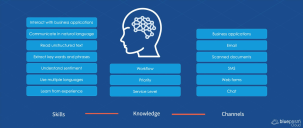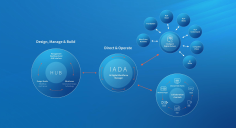Evolution Edition EER4
This document details the application architecture for the Blue Prism Cloud® platform, Evolution Edition. The following sections define the components within a Blue Prism Cloud Software-as-a-Service (SaaS) deployment, configuration and capabilities.
Blue Prism Cloud®
Blue Prism Cloud brings together the principles of Cloud, Robotic Process Automation (RPA) and Artificial Intelligence (AI) to offer a proprietary Software as a Service (SaaS) platform designed to automate and digitize the execution of knowledge-based work. Digital workers are deployed non-disruptively into business operations and work by emulating the way people use business systems, the decisions they make and the processes they follow, to augment, replace, or digitize manual work processes.
Logical architecture
The Blue Prism Cloud logical architecture is illustrated below, with details of their operation covered in the following sections. The Blue Prism Cloud digital workforce is centered around capabilities that underpin its ability to support business outcomes. These categories are:
The Skills required to do something. Skills include the following functionalities:
- The ability to use business applications like a human worker does, interacting with the existing application interface and emulating a human worker
- The ability to communicate, interpret, extract and generate natural language
- The ability to read unstructured text from emails or document images
- The ability to identify key pieces of information, interpreting not only the intent of the communication, but also the sentiment
- The ability to translate from more than 60 languages
- The ability to use machine learning to improve over time
The Knowledge on how to do the required skill. Knowledge is the information about a given task, process or activity which is taught to the digital worker. Essentially, this is the workflow required to complete a business process, which is defined into a series of actions and decision logic. Each business process will be categorized with a priority and business service level so that the platform can effectively orchestrate a variety of tasks and processes in an order which is relevant to the business.
Channels is the framework of communication into the platform and to the digital workforce. Whether this is through standard business applications, through email or a text message, through reading a scanned document, through information provided online via a web form with human/digital worker collaboration or through a real-time conversational interface such as chatbot.
Component architecture
The following items detail the sub-components of the Blue Prism Cloud® platform, including their function and capabilities.
Direct and operate
At the core of the platform is IADA®, the Intelligent Automated Digital Assistant. This operates as the digital brain within the digital workforce, supporting the communication of the sub-components, creating machine learning driven levels of utilization and providing cognitive capabilities to the digital worker execution layer.
A key function of IADA is its orchestration capability. IADA Orchestrator acts as an intelligent virtual supervisor for the digital workforce, coordinating the allocation of tasks (automated processes) based on business relevant metrics. IADA Orchestrator is configured to be aware of process and application performance trends, along with priority and service level expectations, to maximize workforce utilization. IADA Orchestrator autonomously load-balances the digital workforce maintaining an internal queue to ensure that if digital workers are not immediately available, processes are queued for execution by the next suitable digital worker.
Key features include:
- Managing the auto-scaling of the digital workforce, activating new workers as required, ensuring the availability of scale-up resources should they be required and managing the scale-down of resources no longer required;
- Marshalls access to processes by, protecting Process Database access, acting as the single decryption point of any credentials or parameters and ensuring complete segregation of the processes, access credentials and reporting information;
- Exposes a middleware layer which allows organizations to leverage existing systems to push jobs directly to the platform for scheduling and execution via an exposed API.
Within the EER4 platform two IADA Orchestrators are deployed in a primary and standby configuration. This enables the testing of Blue Prism upgrades prior to a deployment to the Production environment.
Design and manage
Powered by the intelligence data collected from IADA, Hub supports the operators and controllers of the platform. Hub is a web accessible interface used to command and monitor your digital workforce. Hub provides users secure access to:
- Management Information
- Workforce Process Prioritization
- Automation Customization and Development
- Process Log and Exception information
- OCR/iOCR Analysis
- Intelligent Schedule Advisor
- Real Time digital worker views
- Component Library
- Wireframer development tools
- Digital worker Live Access
Build
The build aspects of the platform contain two key elements.
- Wireframer – Allows the automation developer to rapidly deploy business objects and actions that will form the structure of the business process being automated. The simplicity is the ability it allows in the definition of these business objects and actions, along with best practice techniques, to ensure that enterprise grade automations are always built.
- Blue Prism Design Studio – Forms part of Blue Prism, is the component used to capture the business process steps and actions in the form of a workflow. The simplicity of Blue Prism Design Studio enables individuals with no experience of programming to capture a business process and to simulate its actions.
Digital worker
Blue Prism Cloud digital workers employ Intelligent Automation (IA) to manage the execution of processes through following a defined workflow and interacting with applications and systems through their standard user interface (UI). This is performed using the Blue Prism Runtime environment. Blue Prism Cloud digital workers are generic run-time instances, not hard coded to any particular work task, process, job queue or department, but available as resources to execute work as orchestrated by IADA. Digital workers have a set of continually evolving external capabilities which can be consumed by the digital workforce within the overall platform. Current features supported include:
- Translation – Converting a naturally formed message into over 60 supported languages
- Natural language processing – Read – extracting the sentiment, key phrases and language from a message
- Natural language generation – Extracting numerical or statistical information which is then transposed into naturally formed written language
- Natural language understanding – Understand – extracting the sentiment behind text whether this is in the form of an email or a chatbot message
- IADA vision – A mechanism for interpreting images and in real-time, producing information in a machine-readable format
- AI skills – Expands the capabilities of the digital worker to “learn” from previous work tasks performed and improve performance and efficiencies of the digital workforce
Channels
To get data into the platform is a key requirement, whether this is structured or unstructured data, the data will have to be processed from a variety of sources. These include the following:
- Business application – This is the ability to interact with a business application, using the application user interface, the same way that a human worker would.
- Email – A Blue Prism business object artifact that has been designed to allow a more fully flexible and powerful email management solution for Intelligent Automation. This is used by the digital workforce to provide a complete email management tool for Microsoft Outlook. The artifact also accepts input and output of native design data structures such as Collections. There is no need to mess around with JSON, XML or List objects, with complex and unreliable conversion functions.
- OCR (Optical Character Recognition) – OCR delivers the functionality of turning image-based inputs such as TIFF and PDF files into machine searchable data using optical and image character recognition. Any material will be ingested, decompiled and the output passed to the IADA Orchestrator as a machine searchable format and used as part of an automated process. Blue Prism Cloud is capable of further extending the use cases available by being able to inspect and extract only relevant items within a document against a set of ‘learned’ criteria created through observing the actions taken by SMEs. This practice requires examples to be learnt and over time to allow it to become more autonomous (confident) to extract and process material with no human input. To support a scenario where the platform was low in confidence i.e. unable to identify the required information, the item is passed to a human for verification.
- SMS – Text messages interpreted by the platform allow an interaction with an automated business process.
-
Chat – Enables end users to engage with the Blue Prism Cloud platform through using a conversational user interface (CUI). Chat uses natural language processing to understand the context and intent of a discussion to understand and identify a user, interpret their requirement and then collect the necessary inputs to pass the task for execution. Chat is non-industry, non-use case specific, meaning it is entirely flexible and configurable to a business function.
-
Web Forms (Interact) – The Interact interface is a customizable web portal, accessible from any computer or mobile device via a browser, which allows organizations to address a range of processes requiring manual initiation (attended automation) or intervention (human/digital worker collaboration) including numerous front-office use cases.
Interact acts as both an initiation point for jobs, and a presentation layer for any results. Established as a client-specific, multi-faceted configuration and therefore Interact can give a highly customized look and feel to each user within an organization’s internal or external user base, based on their configuration.
Access controls dictate which options (automated processes) are available to each user, and thus a single instance can present different options dependent on a role, group, or customer classification.
Interact is service catalogue-oriented and presents automations in the form of customized items, typically displayed as icons and/or drop-down menus, behind which dynamic web forms can gather information needed to drive an automated process. This allows for a dynamic set of fields / questions to be displayed based on the prerequisite information of the activity to be carried out.
Two Interact systems are deployed in a production/development configuration. This enables the testing of Interact process upgrades prior to a deployment to the Production environment.
 Docs
Docs




